Low-calorie, but at the same time sweet vegetable with a pleasant aroma - pumpkin "Honey"
Honey pumpkins have long been known among the healthy diet advocates. Large, ripe vegetables have an unusual taste reminiscent of fresh honey. It does not take much time and effort to grow a crop: it is unpretentious, resistant to diseases and cold weather.
The content of the article
Description
The name Honey is common to several varieties that differ in external characteristics, but similar in taste. The varieties are mostly mid-season: ripening does not occur earlier than 110 days. Plants are unpretentious to care for, resistant to temperature changes, withstand a slight cold snap. They have long whips that grow over 1 m.
Pumpkin is cultivated in any climatic zone. Depending on the region, the planting method changes: they sow the vegetable directly into the ground only in the southern regions, in colder climates grow seedlings.
The varieties have an increased immunity to common diseases and pests.
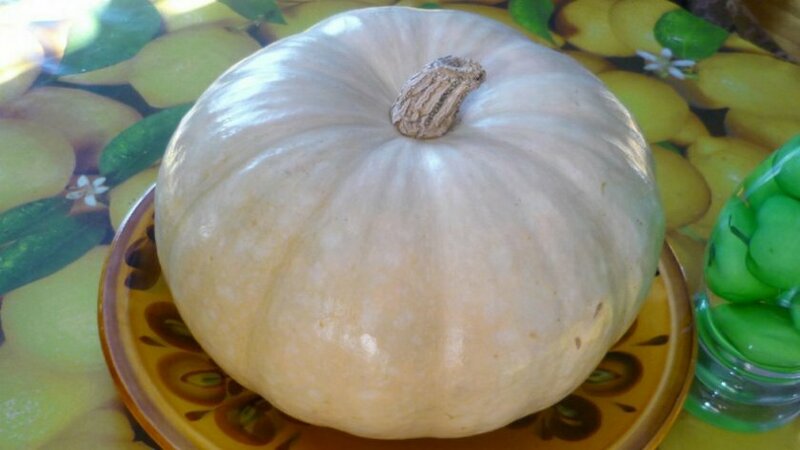
Distinctive features
The seed fund remains germinating for several years, so it is not necessary to plant seeds collected last year. Any soil composition is suitable for growing a vegetable crop, except for clayey. In such a soil, it will not be possible to get a rich harvest.
Fruit characteristics
Depending on the variety, honey pumpkins vary in weight and shape. Mostly ripe vegetables are orange in color and the flesh is the same color. Average weight - 2–5 kg, round-flattened shape. The taste is sugar, the pulp is juicy, tender. The rind is thin, but protects the vegetables from damage.
The photo shows one of the varieties of honey pumpkins.
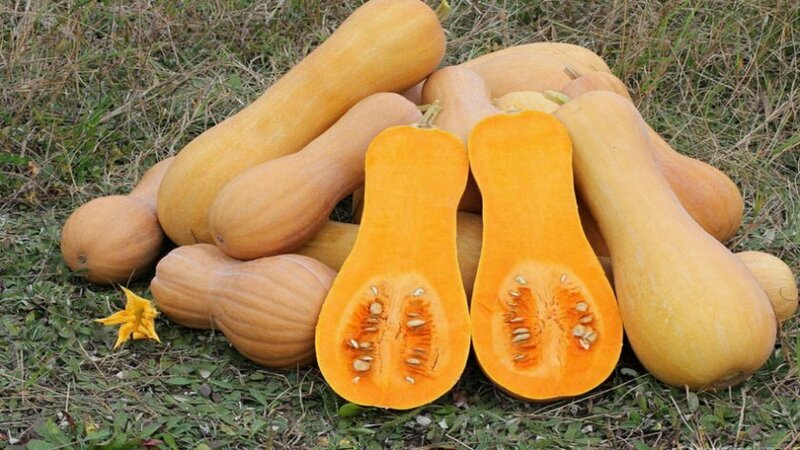
Yield
The yield of such varieties is high: the average is 10-15 kg per 1 m2. Productivity is influenced by climatic features and soil composition. In light fertile soil, the indicator is the highest.
How to grow
Grow pumpkin through seedlings or direct planting of seeds in the ground. The main thing in both breeding methods is the correct choice of soil and site. The pumpkin grows well in fertile soil on the sunny side.
Planting with seeds
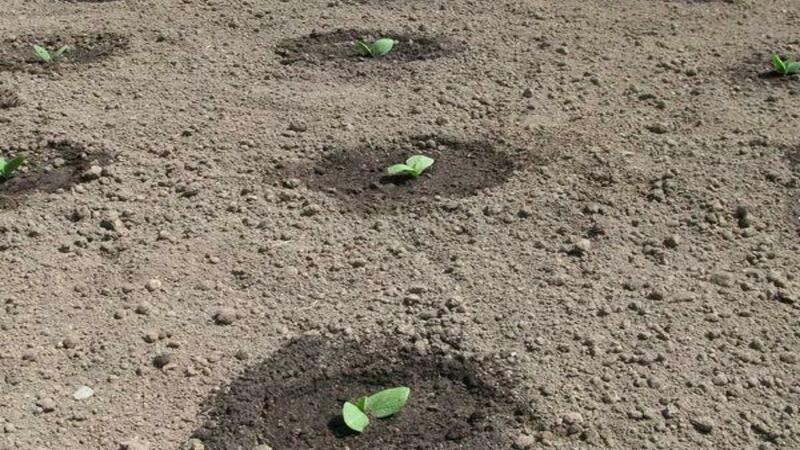
Residents of the southern regions cultivate the vegetable not only by seedlings, but also by direct sowing into the ground. Planting is carried out in late April - early May, when the soil warms up to + 12 ... + 14 ° C.
Seed material is preliminarily disinfected in a weak solution of potassium permanganate for 20 minutes.
3 seeds are placed in a moist hole 5-6 cm deep in different corners. Sprinkle with earth on top and cover with foil until shoots appear. The distance between the holes is 70–90 cm. At a higher frequency of planting, the lashes of plants will interfere with the development of each other. As soon as shoots appear, the film is removed.
No more than 2 sprouts are left in one hole. If all 3 sprouted sunflower seeds, choose those that are stronger, the rest pinch.
Reference. In heavy soil, seeds are planted to a depth of 3-4 cm so that they germinate.
Sowing seedlings
Growing seedlings begins 1 month before transplanting into the ground. Light and fertile soil is bought in a specialized store. If the soil is prepared independently, it is spilled with a solution of potassium permanganate for disinfection. Prepare the soil from garden soil, peat and river sand in equal proportions.
Individual containers are used for planting, with a volume of at least 0.5 liters. Small drainage holes are made at the bottom to drain excess moisture. Spread some sawdust and fill the container with 2/3 of the soil mixture.
Reference. Seedlings do not tolerate picking well and can die at the slightest violation of the root system. Therefore, the seeds are planted immediately in individual containers.
The grains are buried 5 cm, sprinkled with earth on top, slightly moistened, covered with foil and left in a warm place until shoots appear.
Seedling care

When the first sprouts appear, the film is removed, and the containers are placed on the windowsill, closer to the sun's rays. After 10 days, a full complex of minerals is added along with an abundant watering... Moisturize as needed with a fine watering can. They loosen the earth after each watering with a wooden stick, superficially, without touching the young roots.
1 week before transplanting, the seedlings are fertilized again with a full range of minerals.
After the last feeding, young plants are hardened by taking them out into the open air for several hours during the day. This helps the culture adapt more quickly to street conditions.
Transfer to soil
Landing scheme:
- the distance between the holes is 70–100 cm;
- row spacing - 80 cm.
The soil is prepared 2 weeks before planting: it is dug up and humus is introduced.
The sprouts are transplanted into the holes along with the old clod of earth, otherwise the seedlings will not start growing for a long time. The optimal time for transplanting is late in the evening or early in the morning, so as not to burn young plants.
The beds are chosen on the sunny side, but the seedlings are not planted under the scorching sunlight. After transplanting, the holes are watered and left for several days to adapt the plants to new conditions.
Further care
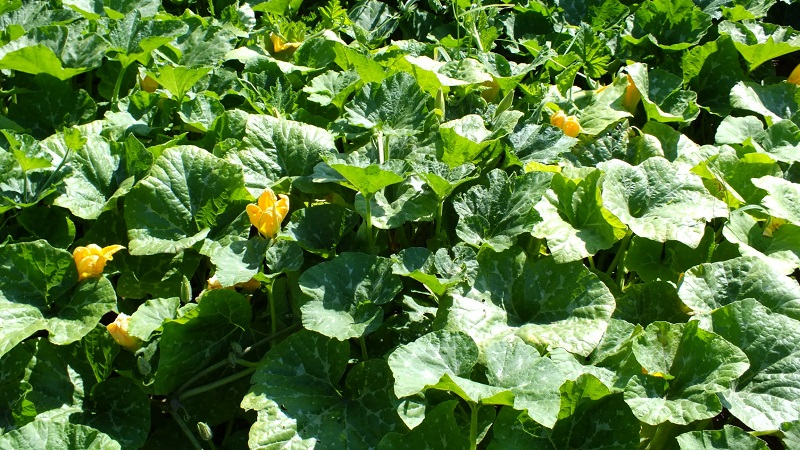
An unpretentious plant does not require complex care. For the full development of seedlings, regular watering and timely feeding are sufficient.
Watering
Water the crop abundantly and regularly before starting flowering. During this period, the earth is not allowed to dry out. As soon as the plants bloom, the amount of watering is reduced. Moisten the earth as the top layer dries. After the fruits ripen, irrigation is stopped.
For the rapid growth of the pumpkin, the ground is periodically loosened, especially after watering. Loose soil promotes better oxygen and nutrient penetration to the roots.
As the weeds grow, the beds are weeded. The grass is removed from the roots, as they take many useful substances from the ground and impede the development of cultivated plants.
Top dressing
Of the fertilizers, an infusion of mullein is used in a ratio of 1 liter to 1 bucket of water. The first time they are fed 10 days after transplanting into the ground. The agent is poured strictly under the root along with abundant watering.
The second time the pumpkin is fertilized during the initial flowering period. The procedure is repeated in 1.5–2 weeks.
The following dressings are carried out at intervals of 2 times a month.
Formation

Plucking the lashes allows you to get large fruits. If the quantity ovaries do not regulate, vegetables will grow small.
No more than 4 ovaries are left on the shoot, the rest is pinched, thereby stopping the growth of the lash and the formation of new fruits. In this case, all nutrients will be spent on the already existing ovaries.
To stop the growth of the lashes, the part that leaves after the 5th leaf is sprinkled with earth.
reference... The colder the region of cultivation, the less ovaries are left on the shoot.
Growing difficulties
During the growing season of the crop, a net or props are installed along which the plants will sprout. On wet ground they rot and become the cause of the spread of fungal infection.
For the full development of 2 seedlings growing from one hole, the shoots are directed in opposite directions.
Tips from experienced gardeners

The recommendations of experienced vegetable growers will help you get harvest with the lowest losses:
- With direct planting of seeds in the ground, after the sprouts appear, they are covered with caps.This creates a greenhouse effect for the pumpkin to grow quickly later. This shelter protects the seedlings from precipitation.
- Spread compost around the planting hole. It enriches the soil with useful substances necessary for the rapid germination of seeds.
Diseases and pests
Varieties of honey pumpkins are resistant to fungal and viral pathogens diseases, but in wet weather they are affected by rot. Therefore, in a rainy summer, pumpkin is grown on hills, small hills. Aloe juice helps from decay. Bushes are treated with it, cutting out the decayed parts.
Aphids and wireworms are dangerous pests for pumpkin. The soil is deeply dug from the wireworm, and against the aphid, the plants are treated with a decoction of wormwood.
Harvesting and application of the crop
Harvest honey pumpkin in August - September. Vegetables must be cut with a stalk to increase the period storage.
The crop is laid in a well-ventilated room with a temperature of + 5 ... + 15 ° C. In such conditions, the fruits retain their qualities for up to 7 months.
Ripe vegetables lie in the refrigerator for about a month, and in the freezer for up to 1 year. Before freezing, they are cut into pieces.
The use of pumpkin is universal: it is suitable for baking, cooking porridge, frying. Juice is made from the pulp, it is also consumed raw. Honey pumpkin is used for drying and drying.
Advantages and disadvantages
Advantages of honey pumpkin:
- the possibility of breeding in any region;
- cold resistance;
- unpretentious care;
- disease resistance;
- large fruits;
- honey taste;
- high keeping quality;
- marketable condition;
- universal application.
The main disadvantage is long lashes, because of which you have to install supports.
Varieties of honey pumpkins
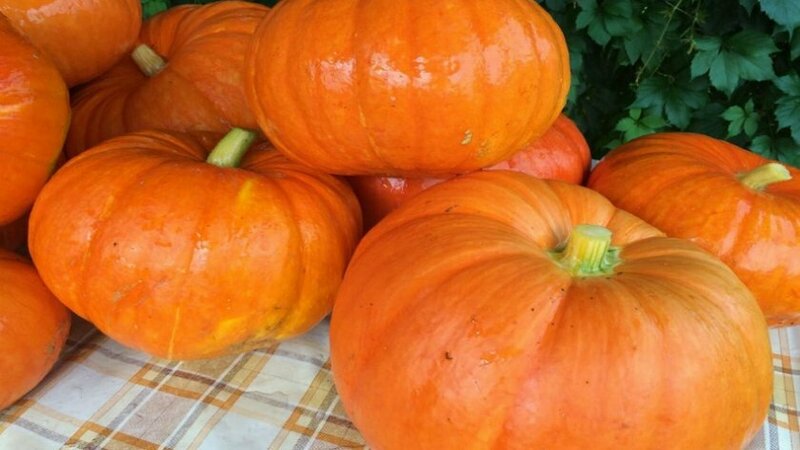
Such a pumpkin has many varieties, each of which has its own characteristics.
Orange F1
Full ripening of the hybrid occurs in 120 days. The color of the peel is dark orange with pronounced gray stripes along the edges. The length of the lashes reaches a little more than 1 m. The weight of ripe fruits is 2-3.7 kg. The pulp is reddish-orange sugar. In cooking, the vegetable is versatile.
Dessert
The variety has large, rounded fruits, slightly flattened on both sides. The color is dark pink. The ribbing is very pronounced. Juicy orange pulp. The mass of vegetables is 3.5–5.8 kg. Early ripe variety - ripens in 90 days.
Guitar
Variety differs from other varieties in its unusual shape, reminiscent of a guitar. Fruit length - 60–70 cm, diameter - 11–13 cm. The peel is thin, light. The pulp is rich orange, takes up 90% of the whole vegetable. Pumpkin is often eaten raw because of its tenderness and sweetness. The variety is mid-ripening - the fruits ripen in 110-120 days.
A princess
The color of the peel of this pumpkin is slightly orange, dull, the shape is rounded-flattened. The pulp is bright orange sweet, contains a lot of sugar and carotene, therefore it is suitable for baby and diet food. Fruit weight - 3-4 kg. The variety is mid-season: the growing season is 115–120 days.
Story
Pumpkin Honey Tale outwardly is very similar to Dessert: it has the same bright orange color and strongly pronounced ribbing. Weight does not exceed 4 kg. The pulp is the sweetest of all. Full maturation occurs 120 days after planting.
Chit
Latest grade: fruits ripen no earlier than 120–128 days. The vegetables are practically the same size, the average weight is 3 kg. The shape is round, the color of the peel is ashy with pale pink spots. Ribbing is poorly expressed. The pulp is deep yellow in color. Pumpkin is versatile in cooking. Variety Honey crumb bushy, not climbing.
Farmers reviews
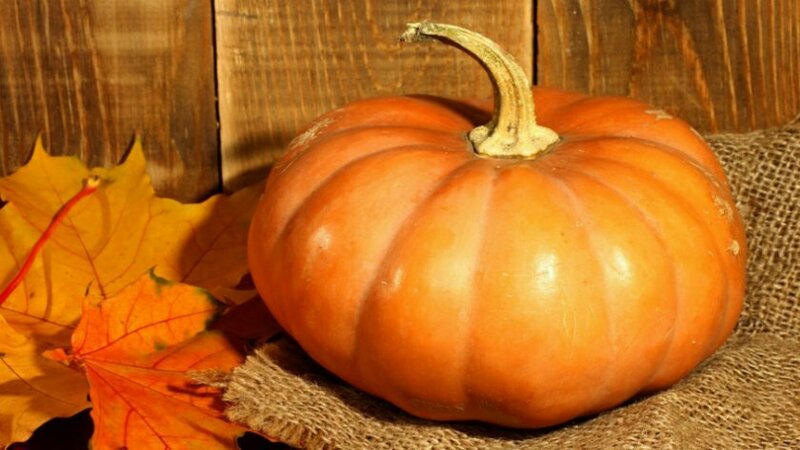
Positive feedback from gardeners complements the list of benefits of honey pumpkins:
Ekaterina, Ufa: «I have been growing honey pumpkins for 3 years because of their juiciness and tender pulp. Caring for vegetables is not difficult, and the harvest is always pleasing. The only thing is that I must sprinkle the lashes with earth when they grow more than 1 m. So new fruits are not tied to them, and those that are already there grow larger. Most of all I like the baked pumpkin. "
Stanislav, Saratov region: “I love pumpkin in different dishes. I plant many varieties myself, including honey ones. I like their taste, delicate, juicy and sugar. Plants do not get sick and do not require much attention during the whole season. I make various dishes from ripe vegetables, but my favorite is porridge. "
Conclusion
When growing honey pumpkins, it is possible to get a rich and tasty harvest with minimal investment of time and effort. An unpretentious culture with strong immunity and resistance to cold weather will delight all connoisseurs of pumpkin flavor. The versatility in cooking allows you to add ripe vegetables to various dishes, prepare juices for the winter.